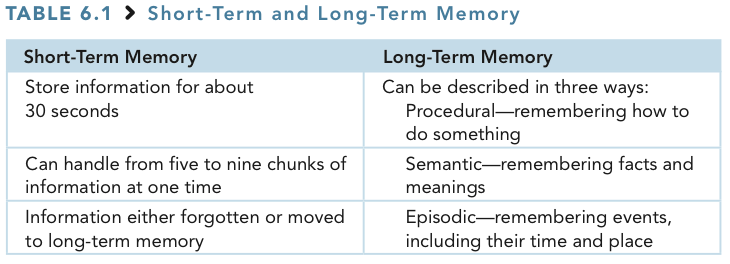How Memory Works
Learning experts describe two different processes involved in memory (see Table 6.1). The first is short-term memory, defined as how many items you are able to understand and remember at one time. After less than 30 seconds, you will forget the information stored in your short-term memory unless you take action to either keep that information in short-term memory or move it to long-term memory.
Although short-term memory is limited, it has a number of uses. It serves as an immediate holding tank for information, some of which you might not need for long. It helps you maintain your attention span so that you can keep track of topics mentioned in conversation, and it enables you to focus on the goals you have at any moment. But even these simple functions of short-term memory fail on occasion. If you’re interrupted in any way, by a ringing phone or someone asking a question, you might find that your attention suffers and that you have to start over in reconstructing the contents of your short-term memory.
The second memory process is important for college success. Long-term memory, the capacity to retain and recall information over the long term, from hours to years, can be divided into three categories:
- Procedural memory deals with knowing how to do something, such as solving a mathematical problem or driving a car. You are using your procedural memory when you ride a bicycle, even if you haven’t ridden in years; when you cook a meal that you know how to prepare without using a recipe; or when you send a text.
- Semantic memory involves facts and meanings without regard to where and when you learned those things. Your semantic memory is used when you remember word meanings or important dates, such as your mother’s birthday.
- Episodic memory deals with particular events, their time, and their place. You are using episodic memory when you remember events in your life—a vacation, your first day of school, the moment your child was born. Some people can recall not only the event, but also the very time and place the event happened. For others, although the event stands out, the time and place are harder to remember.
